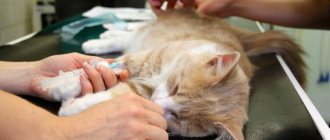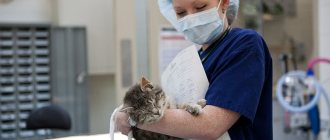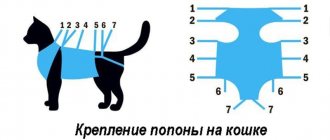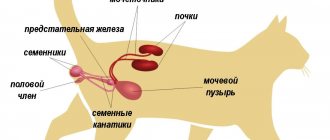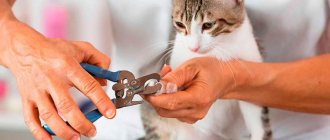Causes of cryptorchidism in cats Diagnostics Treatment Caring for a cat after castration Cryptorchidism in cats is a congenital developmental pathology in which one or both testicles (testes) do not descend into the scrotum, but remain and develop in the abdominal cavity or in the inguinal canals. Typically, an owner notices cryptorchidism in their pet at the age of 2-4 months. However, some owners are unaware of the existence of this problem for quite a long time.
It is believed that cryptorchidism is inherited, so cryptorchid animals are recommended to be castrated and removed from breeding.
In cats, unilateral cryptorchidism most often occurs - that is, when only one testis does not descend into the scrotum, the second one develops normally. Such cats are capable of reproduction. Less common is bilateral cryptorchidism, the undescended state of both testes; with this pathology, the cat most often remains sterile, that is, incapable of reproduction - this is due to the fact that the temperature in the abdominal cavity is higher than necessary to maintain the viability of the seed.
Depending on the type of development, cryptorchidism can be inguinal or abdominal (sometimes also called abdominal). With inguinal cryptorchidism, the testicles are located in the inguinal canal, with abdominal cryptorchidism - in the abdominal cavity.
What is cryptorchidism
To begin with, it’s worth knowing what kind of cryptorchids are they? This is a pathology of the anatomical development of males, in which their testes remain in the abdominal cavity or in the lumen of the inguinal canal. And yes - initially the testicles are located in the abdominal cavity. They descend into the scrotum approximately at the onset of puberty. This happens under the influence of sex hormones and other factors.
Cryptorchidism occurs in approximately 2% of all cats. In most cases, only one testicle is “lost” (unilateral cryptorchidism), but in very rare situations anorchism is observed (i.e. the cat’s scrotum is completely empty). Veterinarian research has shown that with classic cryptorchidism, the testes get stuck in the inguinal canal.
It is believed that in normal cases the testes should “reach” the scrotum when the kitten is 6 to 8 weeks old.
It should be taken into account that the body of cryptorchids retains the ability to synthesize sex hormones, and therefore such cats have a sexual attraction to cats. However, in most cases, animals with this pathology have problems with successful fertilization of females.
The quality of cryptorchid sperm decreases significantly. It contains a lot of sperm with disturbed body structure and other defects.
The problem is that this pathology is dangerous not only because of the deterioration of spermatogenesis. It is known that the testes remaining in the abdominal cavity are more often susceptible to the development of cancer, sometimes they begin to spontaneously die and collapse, and therefore abscesses form in the abdominal cavity.
Important! Veterinarians have one position - cats with cryptorchidism must be neutered. And the sooner this is done, the better.
But how do you understand that something is wrong with your pet?
Complications from pathology
Cryptorchidism is dangerous, so it needs to be treated in a timely manner; the consequences of this pathology are:
- Cancer. The probability of its occurrence increases 10 times. This happens due to increased temperature in the abdominal space and the impossibility of spermatogenesis, as a result of which first physiological and then genetic changes in tissue occur. The highest probability of developing a tumor is with a unilateral intra-abdominal location of the testicle.
- Testicular torsion. Because of this, a sharp, severe pain occurs, which often does not stop and causes severe suffering to the animal for a long time. In this situation, internal bleeding may also occur if the spermatic artery is damaged.
- Infertility is observed in 80% of cases with bilateral cryptorchidism, but is not recorded with unilateral cryptorchidism.
- Hernias. They often occur from birth. In this case, hernias can, under certain conditions, threaten the life of the animal.
- Prostate dysfunction and its cancerous degeneration.
- With the hormonal nature of cryptorchidism, when the testes do not respond to gonadotropic hormone, a lack of testosterone occurs. A low amount of it leads to increased work of the anterior pituitary gland, which entails a systemic disruption of hormonal metabolism.
Signs of cryptorchidism in cats
Of course, the main symptom is always the absence of one or both testicles in the scrotal cavity. This is easy to notice upon palpation. However, not all owners probe the scrotum of their pets, and even a cat can scratch it painfully.
In addition, in the complete absence of testes, the following occurs:
- The cat is attracted to cats and can mate, but his partners cannot become pregnant.
- Sexual desire fades, despite young age.
- The animal becomes inactive and tends to become obese.
Interesting! About 70% of animals with this pathology still retain the ability to reproduce, so this sign should not be considered reliable.
Unfortunately, in many cases there are no other significant symptoms. Pain with this pathology occurs rarely and only in cases where something has already happened to the testes located in the abdominal cavity (cancer or an inflammatory process).
General features of animals with cryptorchidism:
- The scrotum looks like a wrinkled, flabby sac.
- Cats with this pathology often urinate “like a dog.”
- When urinating, pets cringe strongly, although they do not experience any pain at this moment.
Interesting fact! Unlike “normal” cats, cryptorchids often harass cats even when the latter are not in heat.
- The cats themselves can be very aggressive towards such cats.
- Diseases of the genitourinary system are very often detected.
- Testicular tumors diagnosed incidentally during an X-ray or ultrasound examination of the abdominal cavity.
- In severe cases, it is easy to notice a strong pain reaction in the cat, which manifests itself upon deep palpation of the abdomen. It can be caused by twisting of the testis along its axis. In this case, the vas deferens and vessels are compressed, as a result of which an inflammatory process develops, sometimes leading to necrotic decomposition of the organ.
- Cats with “missing” testicles sometimes begin to... go bald. This is due to a lack of sex hormones.
- In such animals, significant darkening of the skin of the external genitalia is sometimes observed. It is not known exactly what this is connected with. Most likely, this strangeness is also due to changes in the levels of sex hormones.
- Feminization. Due to problems with hormones, such cats lose their “masculinity.” Their skeleton may become thinner over time, and the pet’s appearance becomes more “fragile.”
Despite all the research, the exact reasons causing the development of cryptorchidism have not been identified to this day. Pathology can occur with almost equal probability in animals of all breeds and of any age. However, practicing veterinarians believe that this disease is especially common in purebred cats. In particular, the Persians are “under suspicion”. The body of representatives of this breed develops more slowly than usual (they are even neutered much later), as a result of which problems associated with untimely release of the testes are more common.
Note that in some cases, “lost” testicles can temporarily fall into the scrotal cavity, but only when the cat is excited or very frightened. This phenomenon is also observed when the animal is hypothermic. This is often used by veterinarians, since performing abdominal surgery is an expensive and relatively risky undertaking. If there is even the slightest opportunity to “catch” the testes in the scrotum, you need to take advantage of it.
Let us immediately answer the question often asked to veterinarians: “During castration, is it possible to remove the testicle located in the scrotum, and leave the second one in the abdominal cavity?” The answer is categorical - no, under no circumstances is it possible.
We have already written several times that the testicles in the abdominal cavity are often affected by cancer. But the opposite situation is quite acceptable. If for some reason the owner wants to preserve the reproductive function of his pet, or the cat is too old (7 years and older) for “full” castration, the testicle that has descended into the scrotum can be left. Most likely, such an animal can leave relatively healthy offspring... but you shouldn’t do that (we’ll talk about the reasons below).
Cryptorchids should be excluded from the reproduction process, since this pathology is very often inherited.
Need for surgery
Cryptorchid castration is a more complex surgical procedure than conventional sterilization of a healthy animal. Many owners are afraid to subject their pet to such a procedure.
However, veterinarians strongly recommend castration for cryptorchidism. After all, this anomaly cannot be cured by other methods. The operation is necessary for the following reasons:
- castration prevents the risk of tumors;
- transmission of the defect to offspring is excluded;
- problems associated with sexual behavior (the need to mark territory, aggressiveness) are eliminated.
Often, owners ask the veterinarian not to castrate the animal, but to perform an operation to lower the gonads into the scrotum. However, such surgical intervention is performed extremely rarely. After all, after this operation there is a danger of transmitting the anomaly to subsequent generations and all problems associated with sexual behavior remain. Therefore, in the vast majority of cases with congenital cryptorchidism, experts recommend castration.
Very rarely, in cases of acquired cryptorchidism in cats, surgical intervention is replaced with hormonal therapy. However, in this case, the animal has to inject huge doses of testosterone, which has a negative effect on the body. Such treatment is carried out only if there are serious contraindications to surgery.
Features of cryptorchid sterilization
The cost of castration will be several times higher. This is not a whim of greedy veterinarians. Considering that the “lost” testes are (most likely) in the abdomen, abdominal surgery is required. It involves the mandatory administration of general anesthesia (which in itself is not cheap), the procedure takes many times longer.
Please note that preparation for surgery requires keeping your pet hungry for 12 hours. Another 3 hours before the procedure, the animal should not even be given water.
But sometimes you can get by with a little bloodshed. So, in some cases, the testicles are located close to the exit to the scrotum and can descend there when the cat is under severe stress, or when it is completely relaxed. In such situations, massage of the genital area helps: the testis comes out, it is “caught” and fixed using a loose ligature or elastic band placed on the scrotal sac of the scrotum.
But the main feature of castration of cats is the need for a preliminary medical examination. Using radiography and ultrasound, it is necessary to find out exactly where the organ is located. There are cases when the testicles only slightly did not reach the entrance to the scrotum, being located directly at the inguinal ring. But sometimes they are located deep in the abdominal cavity. Data obtained from research is used to plan surgery.
Preparing for surgery
Before castration of a cryptorchid, the animal is carefully prepared for surgery. The preoperative period consists of the following stages:
- The veterinarian palpates the scrotum and abdomen.
- An ultrasound examination is prescribed. This helps determine the location of the gonads.
- The animal is given a blood test, urine test and an electrocardiogram. The examination allows you to determine your general health.
- If the pet has not been vaccinated previously, then 2 - 3 weeks before castration you need to give it all the necessary vaccinations.
- Approximately 3 weeks before the scheduled operation, anthelmintic treatment should be carried out.
- The day before castration, the animal must be thoroughly washed with antiparasitic shampoo.
- 8 hours before surgery you should avoid eating.
Castration for cryptorchidism
Typically, abdominal surgery is required. To perform castration, it is necessary to dissect all layers of the abdominal wall in order to find the retained testis in the inguinal canal. The walls of the canal are also dissected, the testicular ligament is cut, a clamp and ligature are applied to the cord of the latter.
The organ is removed, and several purse-string sutures are placed on the remaining stump (for reliability). After this, everything is sewn up in reverse order. It is advisable to suture each layer of the abdominal wall with a separate suture, but in young animals you can get by with just one. The surgical technique for removing a testicle that has nevertheless entered the scrotal cavity is no different from conventional surgical castration.
In order for the operation to be successful and there to be no fatal complications subsequently, special attention must be paid to observing the rules of asepsis and antisepsis. The entire surgical field must be carefully cut and shaved, and then treated at least three times with antiseptic compounds.
Given the high complexity of such a procedure, it is performed at home only as a last resort.
This is due to the fact that with the slightest negligence complications inevitably develop. One of the most typical is internal bleeding associated with the application of a poor-quality ligature or its tightening too loosely. In cats with this pathology, total blood pressure quickly drops, all visible mucous membranes sharply turn pale, and the skin becomes noticeably cool. If at least one of these signs appears, you should immediately call a veterinarian. If you do not provide help to your pet as soon as possible, he will most likely die from massive internal bleeding.
Consequences
If a testicle has been removed from the subcutaneous area, the pet can be taken home immediately from the clinic. If the animal has undergone abdominal surgery, then in some cases a hospital stay may be required.
During the postoperative period, you need to carefully monitor your pet's condition. The owner should be wary of the following manifestations:
- severe vomiting;
- hoarse and heavy breathing;
- blue skin;
- rare and weak pulse;
- lack of reaction to light, sounds and touches 6 - 8 hours after anesthesia.
In these cases, it is necessary to urgently contact a veterinarian.
Next, we will look at the rules for caring for different types of animals in the postoperative period.
Castration of a cat with one testicle
Many people believe that castration of a cat with one testicle is an extremely simple operation involving the removal of only one testicle. But in reality everything is much more complicated:
- Before the operation, ultrasound determines the location of the “lost” testis: how far it has gone into the abdominal cavity and where exactly the organ is located.
- First, an abdominal operation is performed (accordingly, anesthesia is required), during which the testis that has gone into the inguinal canal is removed.
- After this, the testicle that remains in the scrotum is removed in the standard manner. Since in such cats the diameter of the inguinal canal is larger than usual (and significantly), it has to be additionally sutured with a purse-string suture.
Postoperative care for a neutered cryptorchid cat
When castrating a cryptorchid cat, postoperative care is more complex than after regular castration of a cat. After castration of a cryptorchid cat, a suture is placed on the skin. To protect the suture, a postoperative blanket is put on the cat. If the seam is in the groin area, the blanket does not always cover it well. In this case, a protective plastic collar is more suitable to protect the seam from licking. Postoperative sutures are treated with skin antiseptics (ioddicerine, betadine). The suture is removed after 10-14 days.
How to care for an operated animal
If after regular castration caring for a pet is relatively simple, then in this case much more is required from the owner of the animal. Thus, it is necessary to ensure complete cleanliness of the postoperative wound, for which the pet should not be allowed outside. At least once every three days it is necessary to bring the cat to change the bandages.
The animal should be kept in a separate room with a minimum of furniture. Chests of drawers, chairs, bedside tables, etc. must be removed from there. This is due to the fact that the cat may try to jump on them, and this can lead to the seams coming apart.
The condition of the seams should be monitored daily. If redness, foul odor and/or pus appear, call your veterinarian immediately. You should not take your pet to the clinic, as in this condition the trip could end badly for him.
After castration, the animal is fed only high-quality, easily digestible food.
On the first day, it is advisable to limit your pet to only light chicken broths, which can be flavored with a small amount (very small) of finely chopped low-fat offal. It is allowed to include a small amount of boiled vegetables put through a blender into the post-operative diet. They contain fiber that stimulates peristalsis. This is a good prevention of constipation, which is often found in pets who have undergone abdominal surgery.
How to identify an anomaly
Cryptorchidism can also be detected at home. To do this, you need to palpate the animal's scrotum. Normally, palpation reveals two formations similar in shape to beans. If only one testis is palpable, then in most cases this is a sign of cryptorchidism.
However, diagnosing your pet yourself can sometimes be difficult. There are also cases of false cryptorchidism. The testicular gland may become dislodged due to sudden muscle contraction. This phenomenon occurs during cold weather or when the animal is frightened. Therefore, it is better to seek help from a veterinarian. The specialist makes a diagnosis of cryptorchidism after repeated palpation of the animal.
Treatment options
It should be said right away that cryptorchidism is not capable of leading a mustachioed pet to death, but this does not mean that it does not need to be treated. Drug therapy is used extremely rarely and does not provide a long-term positive effect. For this purpose, hormonal drugs containing testosterone are usually used. Please note that giving them to a small cat is strictly prohibited, since this hormone negatively affects the hypothalamus of a furry baby, and also slows down the growth of bones in the growing body.
Doctors are convinced that castration of a cryptorchid cat is the best therapeutic option of all possible. The operation will suppress the animal’s reproductive aspirations, and will also relieve it from the risk of neoplastic degeneration of a testicle that has not descended into a malignant neoplasm. Statistical studies have shown that the ideal age to castrate a cat is 7-8 months. Before this, you need to conduct diagnostic studies, including a general analysis of the blood fluid and an ECG, which allows you to rule out heart problems in your pet.
Sterilization of cryptorchid involves abdominal surgery, lasting 1.5-2 hours. During this procedure, the cat is placed under general anesthesia. Surgical techniques vary depending on the type of cryptorchidism.
Inguinal cryptorchidism
The first step is for the veterinarian to shave the patient's fur at the site where the incision will be made. Then the skin and fatty tissue is dissected, and the undescended testicle is completely removed. The spermatic cord is cauterized with a coagulator at the cut-off site or tied into a knot. The last stage is suturing.
After the operation, it is necessary to protect the cat from licking the sutured incision. To do this, it is worth purchasing a special collar at the veterinary store that prevents such an instinctive reaction. This must be done, since along with saliva, the pet can introduce pathogenic bacteria into the wound that has not yet healed, which can lead to inflammatory processes and suppuration. It is also recommended to treat the sutures with an antiseptic, for example, Chlorhexidine, until the sutures are completely healed.
Abdominal cryptorchidism
The operation is in many ways similar to conventional sterilization. A laparotomy procedure is performed along the linea alba of the abdomen, thus revealing the vas deferens, usually located in close proximity to the neck of the bladder. After which the testicle is stretched out and removed, then sutures are applied.
After castration, owners can leave the cat in a hospital, under the supervision of a doctor, or take it home. The second option requires careful and proper care of the operated animal. Basic rules of care include:
- there should be no drafts in the room where the pet is;
- a collar is put on the cat, its stitched wounds are treated with antiseptic agents;
- the owner must monitor the slightest increase in the animal’s body temperature. If it has risen, then you should give him Ketoprofen, calculating the dose depending on the weight of the pet. Under no circumstances try to bring down the fever with “human” medications such as Analgin or Paracetamol, they can provoke an allergic reaction in your furry friend, and even kill him;
- if a castrated cat does not show any interest in food for 2-3 days, then take him to a specialist for examination;
- Often one of the side effects of surgery is problems with bowel movements in cats. If the animal cannot go to the toilet for more than 2 days, then use Vaseline oil. It has a mild laxative effect.
Keep in mind that after surgery, the doctor may additionally prescribe the cat a course of vitamins, as well as hemostatic and antibiotic drugs. It is important to carefully follow all the advice of the treating veterinarian; this will reliably protect the cat from complications and allow him to get back on his feet faster.
Finally, I would like to say that cryptorchidism is not a death sentence for a meowing pet. Even with an undescended testicle, he will fully exist and delight his owners. Castration will help you get rid of the anomaly 100%. After it, the animal becomes calmer, stops marking its territory and does not experience anxiety about satisfying its reproductive instincts.
Postoperative period in horses
Castration of a cryptorchid stallion is a rather complex operation. It leaves a large wound. The recovery period takes about 2 weeks. During this period it is necessary to keep the animal on a short leash. After surgery, antibiotics and anti-inflammatory drugs are indicated.
You need to carefully monitor the cleanliness of the room and the bedding. This will help prevent the wound from becoming infected. It is necessary to protect the animal from blood-sucking insects, as they can spread infections.
For 14 days after castration, the stallion is contraindicated in any physical activity. The food should be light, since disturbances in the gastrointestinal tract negatively affect wound healing.
